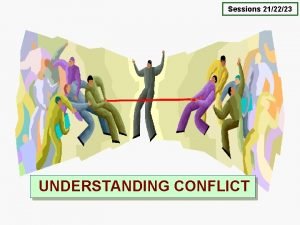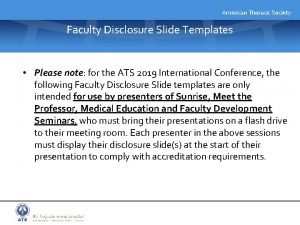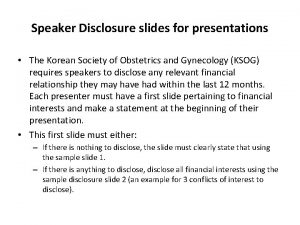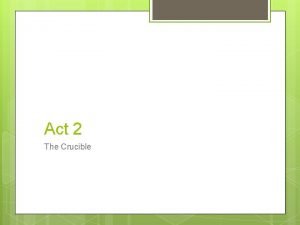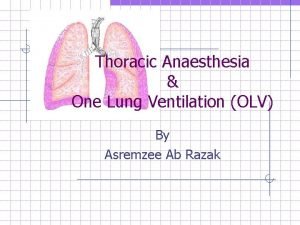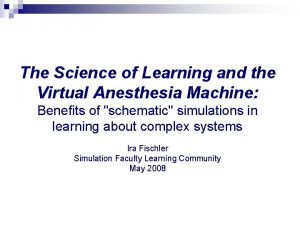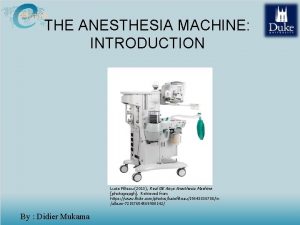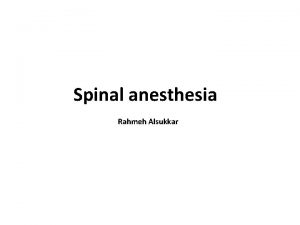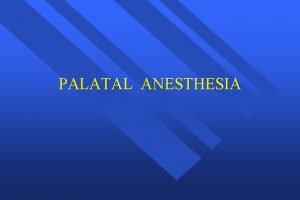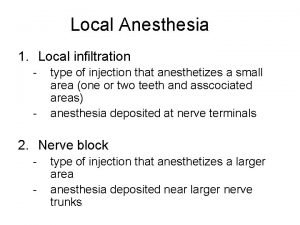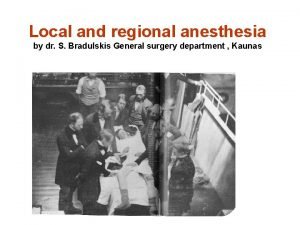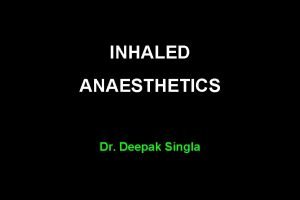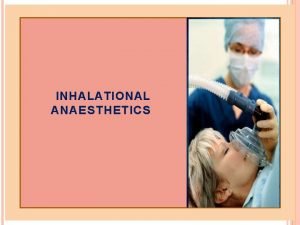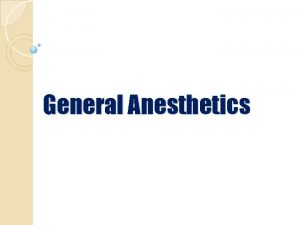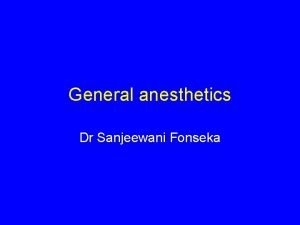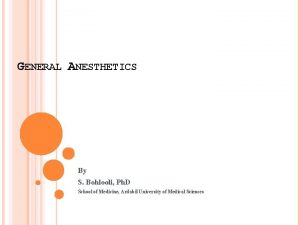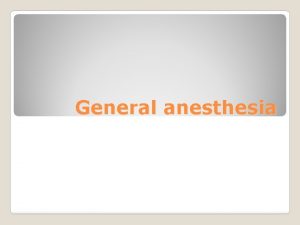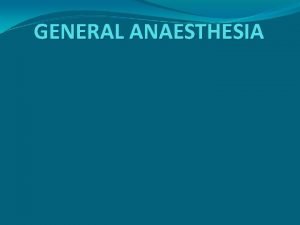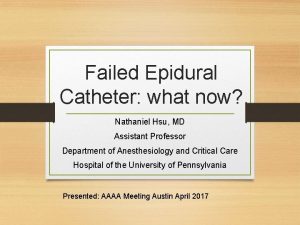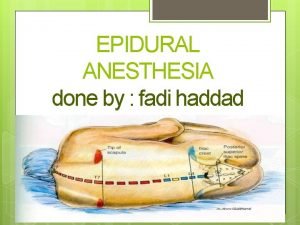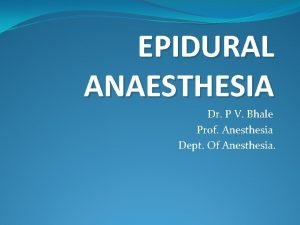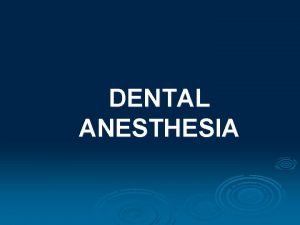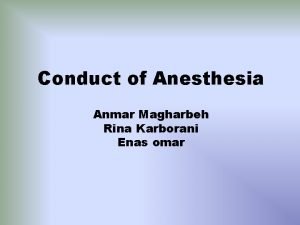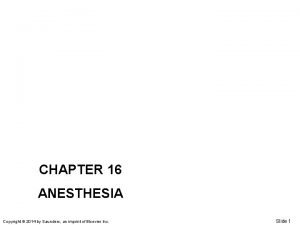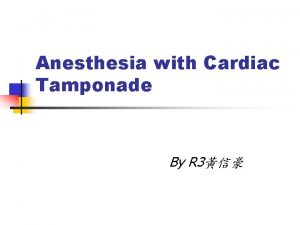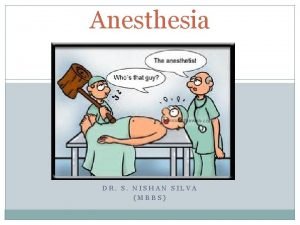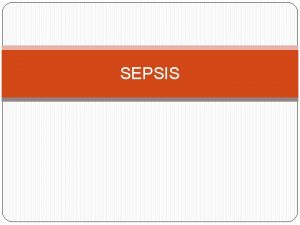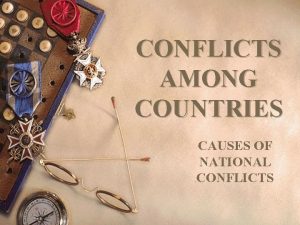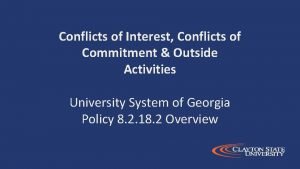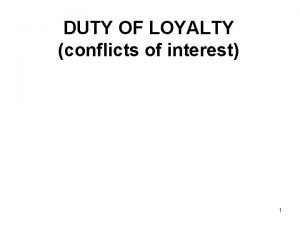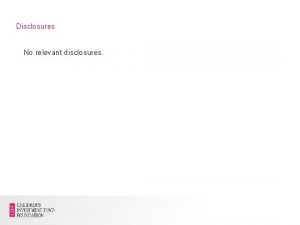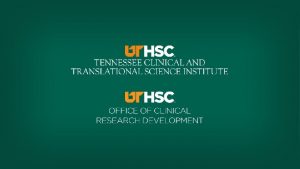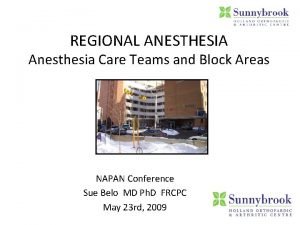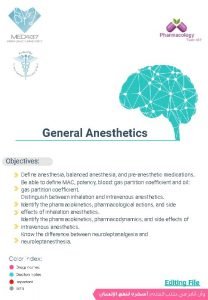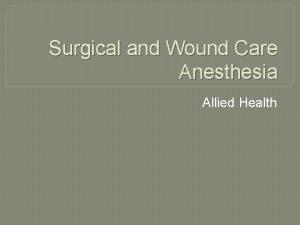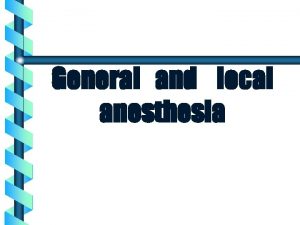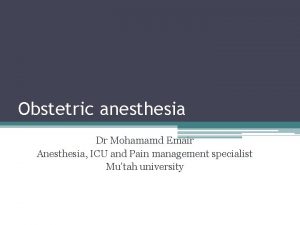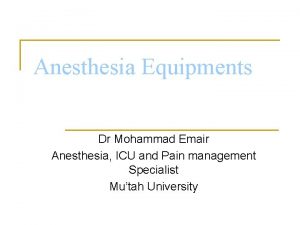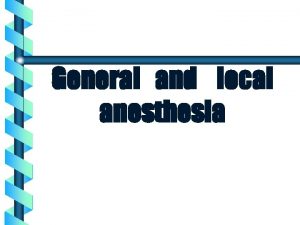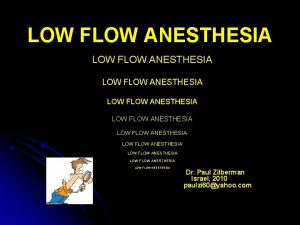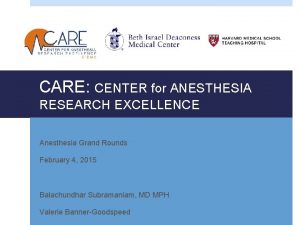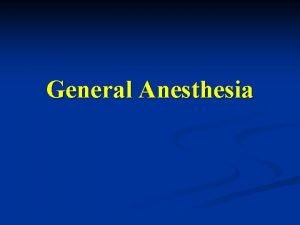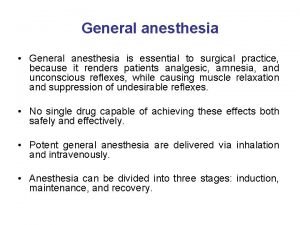No Disclosures No Conflicts of Interest Anesthesia and











































- Slides: 43

No Disclosures No Conflicts of Interest Anesthesia and Culture: Personal Reflections D. John Doyle MD Ph. D Chief, Department of General Anesthesia, Cleveland Clinic Abu Dhabi Professor of Anesthesiology, Cleveland Clinic Lerner College of medicine Anesthesia and Culture Rev 004

Outline • What is culture? • What is medical anthropology? • The challenges of cultural diversity (and the problem of cultural pathology) • The Muslim world • Living in the UAE • Medical practice in the UAE • Conclusions • References

What is Culture? A culture is a way of life of a group of people--the behaviors, beliefs, values, and symbols that they accept, generally without thinking about them, and that are passed along by communication and imitation from one generation to the next. https: //www. tamu. edu http: //www. driveactiondigital. com/our-team/our_culture/

Cultural Competence http: //media-cache-ec 0. pinimg. com/736 x/4 c/0 d/82/4 c 0 d 8210 c 01 d 27 ee 354196 d 5 fa 616 fa 3. jpg

What is Medical Anthropology? Medical anthropology is the study of human health and disease, health care systems, and biocultural adaptation.


“In recent years, evidence-based medicine (EBM), clinical governance and professional accountability have become increasingly significant in shaping the organization and delivery of healthcare. However, these notions all build upon and exemplify the idea of humancentred, individual action. In this book, Dawn Goodwin suggests that such models of practice exaggerate the extent to which practitioners are able to predict and control the circumstances and contingencies of healthcare. Drawing on ethnographic material, Goodwin explores the way that 'action' unfolds in a series of empirical cases of anaesthetic and intensive care practice. Anaesthesia configures a relationship between humans, machines and devices that transforms and redistributes capacities for action and thereby challenges the figure of a rational, intentional, acting individual. This book elucidates the ways in which various entities (machines, tools, devices and unconscious patients as well as healthcare practitioners) participate, and how actions become legitimate and accountable. ” (Amazon. com)

Smith AF, Pope C, Goodwin D, Mort M. Communication between anesthesiologists, patients and the anesthesia team: a descriptive study of induction and emergence. Can J Anaesth. 2005 Nov; 52(9): 915 -20. Pub. Med PMID: 16251555. PURPOSE: Although the importance of communication skills in anesthetic practice is increasingly recognized, formal communication skills training has hitherto dealt only with limited aspects of this professional activity. We aimed to document and analyze the informally-learned communication that takes place between anesthesia personnel and patients at induction of and emergence from general anesthesia. METHODS: We adopted an ethnographic approach based principally on observation of anesthesia personnel at work in the operating theatres with subsequent analysis of observation transcripts. RESULTS: We noted three main styles of communication on induction, commonly combined in a single induction. In order of frequency, these were: (1) descriptive, where the anesthesiologists explained to the patient what he/she might expect to feel; (2) functional, which seemed designed to help anesthesiologists maintain physiological stability or assess the changing depth of anesthesia and (3) evocative, which referred to images or metaphors. Although the talk we have described is nominally directed at the patient, it also signifies to other members of the anesthetic team how induction is progressing. The team may also contribute to the communication behaviour depending on the context. Communication on emergence usually focused on establishing that the patient was awake. CONCLUSION: Communication at induction and emergence tends to fall into specific patterns with different emphases but similar functions. This communication work is shared across the anesthetic team. Further work could usefully explore the relationship between communication styles and team performance or indicators of patient safety or well-being.

Pathological Altruism Barbara Oakley et al. (Eds) Oxford University Press, 2012 ISBN 0199738572 465 pages “ Pathologies of empathy, for example, may trigger depression as well as the burnout seen in healthcare professionals. ” “Hyperempathy - an excess of concern for what others think and how they feel - helps explain popular but poorly defined concepts such as codependency. ” “ …pathological altruism, in the form of an unhealthy focus on others to the detriment of one's own needs, may underpin some personality disorders. ”



Medicine and Culture • Folk healers / Shamans • Tolerance of pain and suffering • Women as “impure” • Religious influences • Religious medical ethics versus secular medical ethics

Medicine and Religion • • • Euthanasia Suicide Pain and suffering Blood transfusions Faith healing Abortion Brain death Contraception Pregnancy / Obstetrics Organ transplantation

Medicine and Religion “The physician, taking nothing for granted, reasoning deliberately, prolonging life by every means in his power, stands out in contract to the priest, whose mind is bent on the future, and who regards the body as of secondary importance. ”

“Although America is the most medically advanced place in the world, many people disregard modern medicine in favor of using their faith to fight life-threatening illnesses. Christian Scientists pray for healing instead of going to the doctor, Jehovah’s Witnesses refuse blood transfusions, and ultra. Orthodox Jewish mohels spread herpes by using contaminated circumcision tools. Tragically, children suffer and die every year from treatable diseases, and in most states it is legal for parents to deny their children care for religious reasons. ” http: //paul-offit. com/booksby/bad-faith/

After learning of the use of chloroform by Queen Victoria at the birth of Prince Leopold, The Lancet in an editorial challenged the accuracy of the information, and then condemned the Queen's physicians and Dr. John Snow (although not by name) for even considering anesthesia. http: //www. ph. ucla. edu/epi/snow/lancet 1853 reaction. html John Snow Queen Victoria James Young Simpson • Simpson JY. Notes on the employment of the inhalation of sulphuric ether in the practice of midwifery. Monthly J Med Sci 1847 -8; 7: 721 -8. • Simpson JY. On a new anaesthetic agent, more efficient than sulphuric ether. Lancet 1847; ii: 549 -550. • Simpson JY. Answer to the religious objections advanced against the employment of anaesthetic agents in midwifery and surgery. Edinburgh: Sutherland & Knox. 1847.


“Pain is a gift from Allah” Dutch Islamists Refuse Pain Treatment Recalling that the Koran says one must be alert before Allah, some Muslims are refusing palliative care, fearing that it would leave them drowsy on their death beds. Prof. Wouter Zuurmond of the Vrije Universiteit Medisch Centrum in Amsterdam has seen this pattern while working at the Kuria Hospice, which he manages. He finds the situation frustrating, knowing as he does that pain management need not make one drowsy. Accordingly, VUMC organized a symposium on March 29 about providing palliative care to Muslim patients. (March 31, 2009) http: //www. danielpipes. org/blog/2005/06/isla mists-in-the-hospital-ward

What is Cultural Pathology? Cultural beliefs or practices that if widely held and acted on inevitably results in injury, misery, suffering, despair or death.

Some Examples of Cultural Pathology


Her royal boat capsized. Despite the presence of many onlookers, they were forbidden on pain of death to touch the queen – not even to save her life!

According to Wikipedia, homosexuality is a capital offense in the UAE but in a recent Amnesty International report, the organization said it was not aware of any death sentences for homosexual acts. In the UAE all sexual acts outside of marriage are banned (creating a problem for preoperative pregnancy testing programs).

Gun Violence USA

Ritual Female Genital Mutilation

The Muslim Faith

The Muslim Faith • • • Monotheistic / Abrahamic religion based on the Quran, which muslims consider to be the verbatim word of God as revealed to the prophet Muhammad. Five pillars Originated in Mecca and Medina at the start of the 7 th century. 1. 6 billion Muslims world-wide. Sunni Muslims are the largest denomination (85%) with Shiites at about 15%. The two denominations don’t always get along. Other denominations (e. g. , Druze) also exist.

Five Pillars of Islam • Shahadah: Declaring there is no God but Allah, and Muhammad is His Messenger. • Salat: Ritual prayer five times daily 1. • Sawm: Fasting and self-control during the holy month of Ramadan 2 . • Zakah: Giving 2. 5% of one’s savings to the needy • Hajj: Pilgrimage to Mecca at least once in a lifetime (if able to). 1 Logistical implications for anesthesia 2 Clinical implications


Muslim Forces Anesthetist from Operating Room Doctor Philippe Becx from Bree, Belgium, was called to the hospital in the middle of the night because a woman had to undergo an emergency caesarean section. However, her husband blocked the door and demanded a female anesthetist. The latter was unavailable. After a two-hour discussion proved fruitless, an imam was summoned. The imam permitted the doctor to apply an epidural injection, but only if the woman was fully covered with only a small area of skin showing. During the surgery itself, performed by a female gynecologist, the anesthetist was to remain in the hallway. Through a door that was slightly ajar, he shouted instructions to a nurse who was monitoring the anesthesia. According the hospital’s directors, the doctor acted with ‘admirable understanding. ’ He would have been in his right to have the man removed by police. http: //www. religionnewsblog. com/19778/islamic-extremism-13

Life in the UAE Composed of seven emirates Only 44 years old Benevolent monarch Most progressive culture in the region (some exceptions) • In 2013, the UAE's total population was 9. 2 million, of which 1. 4 million are Emirati citizens and 7. 8 million are expatriates. • Despite the sunny environment, there vitamin D deficiency is epidemic. • Inshallah [God willing]. • •



Cultural Contrast — Two Emirati women stare at a foreigner wearing a revealing dress at horse racing's Dubai World Cup.

Anesthesia Practice in the UAE Long delays to recruit new doctors Consultants vs specialists Supply chain challenges Frequent last-minute cancellations Must return spent opiate ampoules and vials Strange drug restrictions (e. g. , flumazenil is a controlled drug but naloxone is not) • HAAD largely opaque and not accountable to the clinicians they regulate • Pregnancy testing potentially hazardous • • •

Anesthesia and UAE Culture • Distrust of the medical system • Pregnancy testing a problem in unmarried women • Modesty issues • Late arrivals • Delays to allow prayers • Most women are brought to their appointments by their sons, brothers, fathers, or husbands. • “It’s in God’s hands” / fatalism

Anesthesia and UAE Legal Issues • • • End-of-life decision making No DNR Informed consent Brain death only recently established Controlled drugs in the OR / ICU Criminal vs civil actions following adverse clinical outcomes (see cautionary tale)

Amanda Morris Report: Cancellation of elective cases in a recently opened, tertiary/quaternary level hospital in the Middle East CANCELLATION REASONS Facility reason Financial reason 6% Patient reason 1% Unclear Workup reason 5% 21% 66%

Amanda Morris Report: Cancellation of elective cases in a recently opened, tertiary/quaternary level hospital in the Middle East Patient reason N Patient cancels 43 Patient wants to reschedule 30 No show, no communication 19 Patient refuses 5 Preop instructions not followed 4 No show, patient wants to reschedule 3 Patient transportation 2 Patient wants to go to another hospital 2 Patient's family wants to reschedule 2 Procedure already completed 2 Patient's family does not consent 1 Total 113 % 38. 1% 26. 5% 16. 8% 4. 4% 3. 5% 2. 7% 1. 8% 0. 9% 100%

A Cautionary Tale (UAE) The Guardian 2013 A South African doctor detained in the United Arab Emirates on a decade-old manslaughter charge has returned home after nine months in limbo, declaring: "It's wonderful to be out of that bloody place. " Cyril Karabus, 78, had been convicted without his knowledge of killing a young leukaemia patient in Abu Dhabi in 2002. He was arrested in Dubai last August while in transit to South Africa from Canada. Karabus was acquitted in March but endured countless setbacks and bureaucratic wrangling before finally boarding a flight to Cape Town, where he was greeted with wild cheers and tearful hugs from family members and supporters. "It's fantastic, " said Karabus, meeting his three-month-old grandson, Gabriel, for the first time. "I didn't realise what the welcome would be. It's unbelievable the number of people who are at the airport. “ A leading paediatric oncologist, he helped save the lives of black cancer victims during the apartheid era and pioneered treatment for cancer and blood disorders at the Red Cross hospital in Cape Town, where he worked for 35 years. Karabus had gone to Abu Dhabi for a six-week stint during which he treated a three-year-old Yemeni girl. She had a form of leukaemia with an 80% death rate at the time, he recalled. "It happens. I've had a lot of kids dying of cancer. It wasn't me that killed her, it was the disease. “ He left the UAE because his contract had finished and resents that the charge sheet later described him as a "fugitive" who jumped the country. "The case record had 16 lies in it. It's absolute garbage. You cannot believe the rubbish written there. It's not exactly the best legal system. “ That would have been the end of the matter but for a fateful decision to travel through Dubai when returning to South Africa after attending his son's wedding in Canada. Ruefully explaining his choice of airline and route, Karabus said: "The Emirates fares are usually better than most. “ With time to kill before their connecting flight, Karabus and his family went through immigration to look for an airport hotel. It was then he suddenly found himself under arrest. "You're totally shocked and you're not sure what the hell they're talking about. " South African doctor Cyril Karabus, 78, greets well-wishers as he arrives at Cape Town airport. He was acquitted in March over death of a leukaemia patient. http: //www. theguardian. com/world/2013/ma y/17/south-africa-doctor-uae-death http: //www. theguardian. com/world/2013/ma r/20/south-african-cancer-doctor-uae http: //www. theguardian. com/world/2012/oct /03/south-african-doctor-abu-dhabi

Conclusion The practice of anesthesia, like the practice of medicine in general, requires a working understanding of the cultural issues (“cultural competence”) that medical anthropologists have been bring to our attention for many years. Failure to recognize this reality can harm our relationship with our patients.

Selected References 1: Dahlander A, Jansson L, Carlstedt K, Grindefjord M. The influence of immigrant background on the choice of sedation method in paediatric dentistry. Swed Dent J. 2015; 39(1): 39 -45. Pub. Med PMID: 26529840. 2: Snelgrove H, Kuybida Y, Fleet M, Mc. Anulty G. "That's your patient. There's your ventilator": exploring induction to work experiences in a group of non-UK EEA trained anaesthetists in a London hospital: a qualitative study. BMC Med Educ. 2015 Mar 17; 15: 50. doi: 10. 1186/s 12909 -015 -0331 -4. Pub. Med PMID: 25890264; Pub. Med Central PMCID: PMC 4367902. 3: Livingston P, Zolpys L, Mukwesi C, Twagirumugabe T, Whynot S, Mac. Leod A. Non-technical skills of anaesthesia providers in Rwanda: an ethnography. Pan Afr Med J. 2014 Sep 26; 19: 97. doi: 10. 11604/pamj. 2014. 19. 97. 5205. e. Collection 2014. Pub. Med PMID: 25722770; Pub. Med Central PMCID: PMC 4337347. 4: Paradis E, Leslie M, Puntillo K, Gropper M, Aboumatar HJ, Kitto S, Reeves S. Delivering interprofessional care in intensive care: a scoping review of ethnographic studies. Am J Crit Care. 2014 May; 23(3): 230 -8. doi: 10. 4037/ajcc 2014155. Review. Pub. Med PMID: 24786811. 5: Shattell MM, Nemitz EA, Crosson N, Zackeru AR, Starr S, Hu J, Gonzales C. Culturally competent practice in a pre-licensure baccalaureate nursing program in the United States: a mixed-methods study. Nurs Educ Perspect. 2013 Nov-Dec; 34(6): 383 -9. Pub. Med PMID: 24475599. 6: Wright SM. Cultural competency training in nurse anesthesia education. AANA J. 2008 Dec; 76(6): 421 -4. Pub. Med PMID: 19090309. 7: Smith A, Goodwin D, Mort M, Pope C. Expertise in practice: an ethnographic study exploring acquisition and use of knowledge in anaesthesia. Br J Anaesth. 2003 Sep; 91(3): 319 -28. Pub. Med PMID: 12925468. 8: Chong N, Elisha SM, Maglalang M, Koh K. A successful partnership to help reduce health disparities at kaiser permanente: the institute for culturally competent care and the kaiser permanente school of anesthesia. Perm J. 2006 Spring; 10(1): 53 -5. Pub. Med PMID: 21519458; Pub. Med Central PMCID: PMC 3076986.

 Conflict of interest meaning
Conflict of interest meaning Aaos disclosure slide
Aaos disclosure slide Voluntary disclosures meaning
Voluntary disclosures meaning Disclosure slide presentation
Disclosure slide presentation Website disclosures under companies act 2013
Website disclosures under companies act 2013 No financial interest disclosure statement
No financial interest disclosure statement Real vs nominal interest rate
Real vs nominal interest rate Simple interest
Simple interest Effective interest rate formula
Effective interest rate formula Chapter 9 resolving conflicts and preventing violence
Chapter 9 resolving conflicts and preventing violence Chapter 9 resolving conflicts and preventing violence
Chapter 9 resolving conflicts and preventing violence The old man and the sea criticism
The old man and the sea criticism The crucible act 2 conflict
The crucible act 2 conflict Olv anesthesia
Olv anesthesia Virtual anesthesia machine
Virtual anesthesia machine Fail safe valve anesthesia
Fail safe valve anesthesia Link 25 system
Link 25 system Paramedian epidural layers
Paramedian epidural layers Pre anesthesia assessment form
Pre anesthesia assessment form Anterior palatine nerve block
Anterior palatine nerve block Trigeminal
Trigeminal Mechanism of local anesthesia
Mechanism of local anesthesia B
B Asa block
Asa block Types of local anesthesia
Types of local anesthesia Local anaesthesia
Local anaesthesia Nasal trumpet measurement
Nasal trumpet measurement Classification of inhalational agents
Classification of inhalational agents Inhalation anesthetics
Inhalation anesthetics Minimum alveolar concentration
Minimum alveolar concentration Classification of inhalational agents
Classification of inhalational agents Dr sanjeewani fonseka channeling
Dr sanjeewani fonseka channeling General anesthesia drugs dosage
General anesthesia drugs dosage Residual blockade
Residual blockade Second gas effect
Second gas effect Spinal anesthesia level chart
Spinal anesthesia level chart Spinal anesthesia
Spinal anesthesia Epidural anesthesia medications
Epidural anesthesia medications Anesthesing
Anesthesing Induction anesthesia
Induction anesthesia Contleaks
Contleaks Anesthesia formula btm
Anesthesia formula btm Anesthesia for cardiac tamponade
Anesthesia for cardiac tamponade What is anesthesia
What is anesthesia
